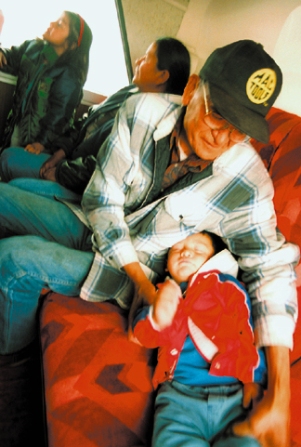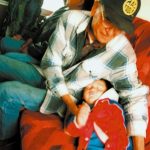
American Indian Reservations are better served under 5311(c)pt
By David Hubbard
Available and accessible public transportation is integral to the quality of life in any community regardless of size and location. Where personal automobiles remain a luxury, a great many Native Americans, particularly the elderly and disabled, must rely on other sources of transportation
While the typical picture of public transit may city buses rolling through urban areas, accessible transportation in the most remote rural communities throughout America is as equally important; maybe more so for the people living and working on the nearly 600 federally-recognized American Indian reservations, whose combined population is deemed 75 percent rural.
SAFETEA-LU created the first Tribal Transit Program funded under Section 5311(c) to enhance access to public transportation for health care, shopping, education, employment, pubic services and recreation in rural an non-urban areas on and around Indian reservations.
 With grants awarded through a competitive selection process, recipient tribes may use these funds for any eligible purpose that includes planning, capital and operating assistance. The program assists in the maintenance, development, improvement and use of public transportation systems in rural and small urban areas.
With grants awarded through a competitive selection process, recipient tribes may use these funds for any eligible purpose that includes planning, capital and operating assistance. The program assists in the maintenance, development, improvement and use of public transportation systems in rural and small urban areas.
The Tribal Transit Program also allows private transportation providers to provide non-urbanized transportation to the maximum extent feasible.
A matter of catching a ride
In areas without tribal transit programs, access is still a matter of catching a ride with family members and friends who drive, hitchhiking with strangers or hiring a taxi service—alternatives that always mean more expense and time spent waiting. Tribal transit immediately lowers the cost for an individual to travel regularly on safe and reliable transportation, making it easier to plan and schedule meetings and appointments and get to work on time.
Get more great articles like this one with a subscription to BusRide!
Click here to subscribe.
But, as in any community, even as the economy improves on Indian reservations, public transportation becomes even more vital to quality of life, calling for expansions, upgrades and improvements to tribal transit systems.
“There is just a high number of people on the reservation who do not have a driver’s license,” says Michael Burns, Northern Cheyenne transit liaison specialist “With the transit system elderly people who want to travel to visit family can ride the early morning bus out of town and come back in the evening.”
Some tribal transit riders do not fall into the typical demographic, but still choose the bus service strictly out of convenience of not having to drive while saving money at the same time — the same reason anyone might take public transit.
The Community Transportation Association of America (CTAA) has listed five of the more successful Tribal Transit currently operating throughout North America.
Rosebud Sioux Transit, South Dakota serves the Rosebud Indian Reservation and communities in Todd and Mellette Counties. Service is provided upon request with regular trips to Rapid City, Pierre, Sioux Falls, Yankton and Valentine, NB
Salt River Pima Maricopa Transit, Arizona covers 86 square miles with five 19-passenger buses equipped with wheelchair lifts. The transit system funded through 5311 (c) provides rides to the general public but is especially beneficial to people with disabilities and senior passengers riders going to medical appointments. Salt River Pima Maricopa Transit provided 39,700 rides last year through both demand response and fixed route services.
Fort Peck Transit, Montana offers a similar demand-response service to the general public operating five buses daily. The transit system began in 1977 and has grown to serve an area of 280 square miles. In 2001, Fort Peck operated 5 buses daily and provided 17,700 rides. Funding from the service comes from the FTA 5311 program with local matching funds from Tribal sources.
Blackfeet Transit, Montana has been providing transportation service since 1978. Blackfeet operates seven vehicles and provides more than 24,000 rides a year to people with disabilities, those going to medical appointments, senior citizens and people transitioning from welfare to work. Blackfeet Transit operates a dial-a-ride service with half of its funding coming from the FTA5311 program and tribal funds to supplement the budget.
Wind River Transportation Authority, Wyoming uses its 18 vehicles to provide transportation to childcare centers, jobs, healthcare appointments and other quality of life destinations in nearby urban areas, such as Head Start programs and senior centers. Wind River characterizes its service as reverse commuting. The agency provides roughly annually over a service area of 900 miles.
In order to provide sufficient levels of funding, training, and technical assistance to tribal transit agencies and to tribes establishing transit agencies, it is necessary to have clear, in-depth, and current information on the level of coverage and other statistics on tribal transit across the country.
The Transportation Research Board determined the transportation predicaments of American Indians were definitely an area needing further study and responded with Tribal Transportation Programs, A Synthesis of Highway Practice.
This study outlined guidance, explanatory materials, example materials and templates that tribes can customize to meet their own needs as they develop their transit systems.
It lists three critical tools to help tribal members provide mobility in their areas:
- Descriptions and provision models of tribal transit services for small and rural communities.
- Practical guidance to develop effective programs that meet the unique needs associated with situations
- Guidance on leveraging resources through alternative organizational models and alternative funding mechanisms.
Using a their share of $32 million in Public Transportation on Indian Reservations funding from the FTA, the Navajo Nation in Arizona and the Eastern Band of Cherokee in North Carolina are building and improving their transit bus facilities.
Do you like this article? Subscribe TODAY to get
BusRide now available in digital!
These are only two examples of 100 transit projects for tribes in 22 states using this funding. $17 million will come from the American Recovery and Reinvestment Act of 2009 (ARRA) Tribal Transit Program.
“We want the economic recovery to reach all of America,” says U.S. Transportation Secretary Ray LaHood. “New and restored transportation infrastructure on tribal lands will help spur and sustain economic growth on those lands.”
FTA national and regional staff members reviewed 152 proposals and selected 100 based on, among other criteria, planning and coordination, demonstration of need, benefits of the project, and financial commitment of the sponsoring organization.
Historically, resources to address the mobility challenges Native Americans face have been limited. But as the CTTA Tribal Transit Conference will show, new programs and funding are coming available that can help build sustainable tribal transit services.
This special conference May 24 -25, will focus on the Federal Transit Administration Tribal Transit Grant Program, coordination of existing services, flexing of funds and other strategies that can provide new opportunities.

Solid information..First time to your blog. Thank you for sharing. I have to revisit this blog. I am very fascinated by the World economy. I know that the United States economy is quickly declining. I guess we will find out!!! Thanks one more time.